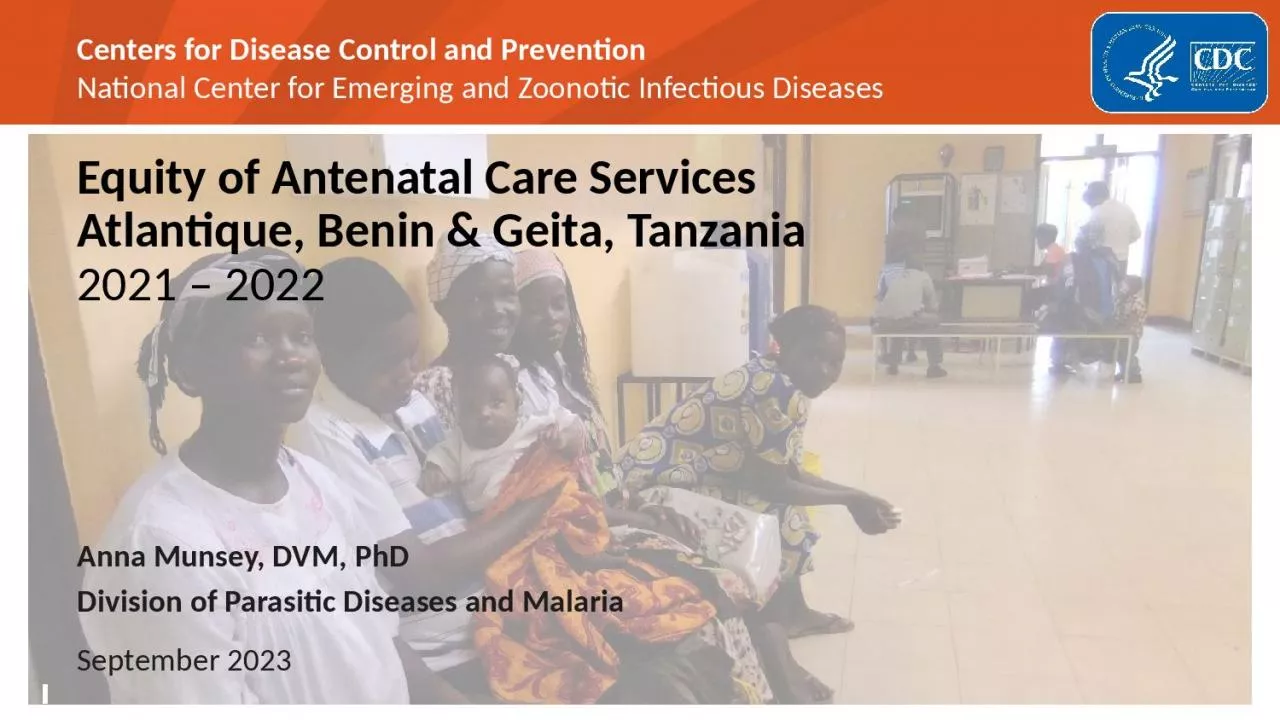

Atlantique Benin amp Geita Tanzania 2021 2022 Anna Munsey DVM PhD Division of Parasitic Diseases and Malaria September 2023 Horizontal equity pregnant women have similar needs regarding minimum quality of care ID: 1042238
Download Presentation The PPT/PDF document "Equity of Antenatal Care Services" is the property of its rightful owner. Permission is granted to download and print the materials on this web site for personal, non-commercial use only, and to display it on your personal computer provided you do not modify the materials and that you retain all copyright notices contained in the materials. By downloading content from our website, you accept the terms of this agreement.
1. Equity of Antenatal Care ServicesAtlantique, Benin & Geita, Tanzania2021 – 2022 Anna Munsey, DVM, PhDDivision of Parasitic Diseases and MalariaSeptember 2023
2. Horizontal equity: pregnant women have similar needs regarding minimum quality of careAvailability and quality of care affected bylocationsociocultural normseducationwealth, costANC through a health equity lens
3. Equity analyses allow identification of disparities amenable to policy change over different time horizons.ANC through a health equity lens
4. Atlantique, Benin: ANC attendees pay a fee for each visitGeita, Tanzania: most ANC services are free for attendeesTwo ANC Financing Structures
5. Study Design & MethodsIs government financing for ANC services equitable?Cross-sectional surveys of recently pregnant womenAssessed ANC outcomes by wealth and education levelsslope and relative indices of inequality; concentration indicesOaxaca-Blinder decompositions (multivariable regressions)
6. ANC OutcomesTotal ANC visitsQuality-of-care indicatorsblood pressureurinalysisblood testsSystem navigationwaiting timedistance to facilitytravel time
7. Results – ANC attendanceWomen do not reach the recommended number of visits in either areaWealthiest, most educated women had 2 more visits than the poorest, least educated
8. Results – ANC attendanceEducation is the most important factor in ANC attendance
9. Results – quality of careGaps in quality of ANC quality of care services identified in both areasAtlantique: quality indicators are higher and do not vary by SESGeita: quality indicators are lower and vary by SES, with facility factors contributing to inequalitiesAtlantique, BeninGeita, TanzaniaRelative index of inequality:blood pressure1.0 (SD = .01)1.2 (SD = .07) **indicates statistical significance
10. Results – system navigationOperational inequalities – wealthier, more educated ANC attendees have shorter waiting timesAtlantique, BeninGeita, TanzaniaRelative index of inequality: waiting time.86 (SD = .07) *.73 (SD = .07) **indicates statistical significance
11. Results – out-of-pocket expendituresPoorer women have higher burden of ANC cost relative to incomeAtlantique: user fees are the primary expenseGeita: transportation is the primary expense
12. ConclusionsInequities are present in both financing systemsAtlantique: reduction of user fees could reduce inequalitiesGeita: training and equipping healthcare staff could improve quality of care
13. AcknowledgementsCDCWalter Ochieng Julie GutmanErik ReavesAhmed Saadani HassaniIMPACT MALARIAJulie NiemczuraJulie BuekensFaustin OnikpoAlexandre BinazonMarie Adeyemi IdohouManzidatou AlaoUniversité d’Abomey CalaviAurore Ogouyèmi-HountoUSAIDChonge KitojoTanzania MOHSijenunu AronSamwel L NhigaFrank ChackyJhpiegoAlen KinyinaMelkior AssengaMary DrakeKatherine WolfStephanie SuhowatskyRuth Lemwayi
14. yck4@cdc.gov